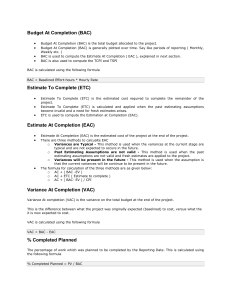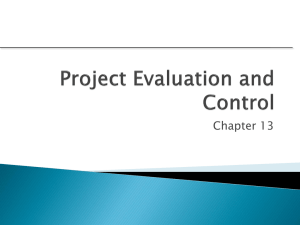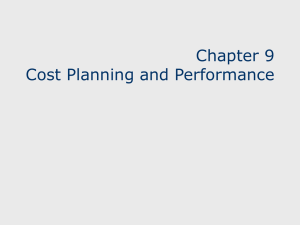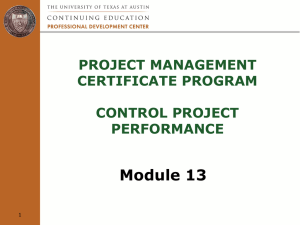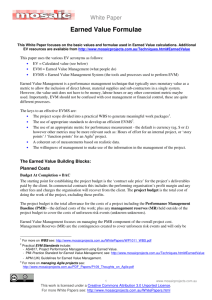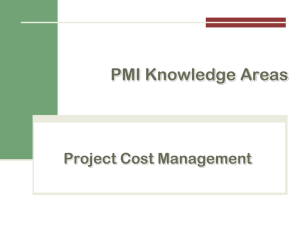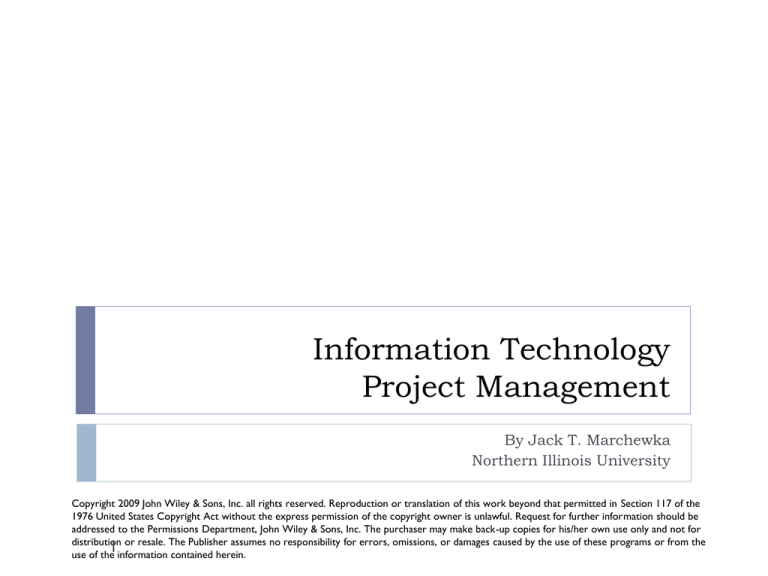
Information Technology
Project Management
By Jack T. Marchewka
Northern Illinois University
Copyright 2009 John Wiley & Sons, Inc. all rights reserved. Reproduction or translation of this work beyond that permitted in Section 117 of the
1976 United States Copyright Act without the express permission of the copyright owner is unlawful. Request for further information should be
addressed to the Permissions Department, John Wiley & Sons, Inc. The purchaser may make back-up copies for his/her own use only and not for
distribution or resale. The Publisher assumes no responsibility for errors, omissions, or damages caused by the use of these programs or from the
1
use of the information contained herein.
Project Communication,
Tracking, and Reporting
Chapter 9
2
PMBOK® Guide Project
Communications Management
Communications planning
Information distribution
Performance reporting
Managing stakeholders
3
Project Communications Planning
Attempts to answer:
How will information be stored?
How will knowledge be stored?
What information goes to whom, when, and how?
Who can access what information?
Who will update the information and knowledge?
What medium of communication is best?
4
Project Communications Management
Identify Stakeholders
Includes the process of identifying people or organizations
that have a positive or negative interest in the project’s
outcome. A stakeholder analysis was described in Chapter 4
to facilitate the understanding of the informal organization.
Plan Communications
A stakeholder analysis provides a basis for identifying the
various stakeholders as well as their interest, influence, and
project role. However, providing relevant and timely
information is an important part in carrying out the different
strategies defined for each stakeholder.
9-5
Project Communications Management
Distribute Information
Focuses on getting the right information to the right
stakeholders in the right format. This may include
documenting minutes from meetings and organizing other
project documents.
Report Performance
Focuses on the collection and dissemination of project
information to the various project stakeholders. This should
include status, progress, and forecast reports.
Copyright 2012 John Wiley & Sons, Inc.
9-6
Project Communications Management
Manage Stakeholder Expectations
Ensuring that clear, consistent, and timely communication satisfies
the information needs and that any project stakeholder issues are
resolved.
The modality of delivery of this information should be included in
the plan as well
E-mail is a powerful tool but face-to-face meetings may be
more appropriate or effective depending upon the situation
7
Monitoring and Controlling the Project
Regardless of how well a project is planned,
unexpected situations will require adjustments to the
project schedule and budget.
A project manager will not lose credibility because an
unexpected event or situation arises.
He or she will, however, lose (or gain) credibility in
terms of how they handle a particular situation.
You don’t want the the project sponsor asking “Why
didn’t you tell me about this earlier?”
Use the baseline as a benchmark against the
actual to act as an early warning system
8
The Project Communications Plan
Can be formal or informal
No news is BAD news – communication is
critical
Supports all of the project stakeholders
Who has specific information needs?
What are those needs?
How will these needs be met?
When can they expect the information?
What will be the format?
9
The Project Communications Plan
Stakeholder
Reporting
Requirements
Report/Metric
Reason
Sponsor or Client
During periodic review
Project Summary,
meetings.
Budget, Earned Value
Time Frame:
Considering projects with
6 months or more of
duration, the project
sponsor can be provided
with this report monthly.
Sponsor or Client will be primarily concerned with the strategic
indicators including overall cost and value in the project.
Project Summary report presents the overall cost that the
project will incur. This report shows the baseline schedule
and budget along with the actual schedule and budget and
gives the project’s overall status report.
The Budget is also a top-of-view project summary of the cost
for all tasks in the project.
Earned Value report gives a top level summary of the project
at a given status date. It also includes key metrics that
monitor the health of the project
Project Manager
At periodic intervals or
even online.
Time Frame: This report
can be sent to the
Project Manager once in
every two weeks for a
typical 6 month or more
projects.
Earned Value, Project
Summary, Slipping Tasks,
Critical Tasks, Milestone,
Current Activities reports,
Over budget tasks and
resources
Project manager will concern with making both operational and
strategic decisions. Therefore, reports that are primarily involved in
tracking the current status of the project and its health are of
utmost importance. The project manager would require to be
informed of the work progress compared to the baseline plan.
Project team
At periodic intervals
Time Frame: Receiving
this report weekly would
help the team members
benefit from it. They
also need to get an
updated copy in case of
any changes in the
schedule.
Who-does-what-when, Todo list
Project team would be concerned with day to day execution of the
project. Issues like who does what and when, what is assigned to a
team member would be key needs. In case of interdependent tasks,
the team members can also see who performs preceding or
succeeding tasks.
10
The Project Communications Plan
Survey of 1,000 respondents reported that the
number 1 reason for IT project failure is…..
POOR COMMUNICATION 28%
INSUFFICIENT RESOURCE PLANNING 18%
UNREALISTIC DEADLINES 13%
11
Project Metrics
Project Metric
A qualitative measurement of some attribute of the
project.
Project metrics should focus on the following
key areas:
Scope
Schedule
Budget
Resources
Quality
Risk
12
A Good Project Metric Must Be…
Understandable
Quantifiable
Easy and inexpensive to create
Proven
Objective (no bias)
Cost Effective
Intuitive, easy to understand
What gets measured gets done
High Impact
Otherwise why bother?
13
Project Measurement Systems Should…
Trying to run a team without a good measurement system
is like driving a car without a dashboard
Allow the team to gauge its own progress
Empowers the team by letting them know when to take
corrective action
Be designed by the project team
With input from outsiders to be sure it is meaningful
Adopt and use only a handful of measures
A few measures keeps the team focused and on the same page
Track results and progress
Easy to understand graphic indicators get the point across
clearly and quickly
14
Earned Value
Suppose you just signed a contract with a consulting
firm called Dewey, Cheatem, and Howe for
developing an IS.
Project Budget, Schedule, Tasks
$40,000
4 months
20 Tasks (evenly divided over 4 months)
$2,000 per task
5 tasks per month
15
The Planned
Project Schedule
And Budget
Task
Month 1
1
$2,000
2
$2,000
3
$2,000
4
$2,000
5
$2,000
Month 2
6
$2,000
7
$2,000
8
$2,000
9
$2,000
10
$2,000
Month 3
11
$2,000
12
$2,000
13
$2,000
14
$2,000
15
$2,000
Month 4
16
$2,000
17
$2,000
18
$2,000
19
$2,000
20
$2,000
Total
$10,000
$10,000
$10,000
$10,000
16
Earned Value Concepts
Planned Value (PV)
The planned or budgeted cost of work scheduled for an
activity or component of the WBS
In our case, our planned value for each task is $2,000
The planned value for each month is $10,000
Budgeted At Completion (BAC)
The total budget for our project
In our case, $40,000 is our BAC since this is what we
expect to pay for the completed project
The BAC is the total cumulative planned value
17
Planned Budget
in 000’s
Budget At
Completion
(BAC)
$ 40
$ 30
Planned Value (PV)
$ 20
$ 10
$0
1
2
3
4
Months
18
At the end of Month 1, we received
the following invoice…
Invoice
Dewey, Cheatem, and Howe
Amount Due: $8,000.00
Payment Due: Immediately
Page 1 of 2
19
This Looks Like Good News!
We expected to pay $10,000 but we’re only being billed
for $8,000
Are we really ahead of our budgeted or planned value by
$2,000?
It depends on what work was accomplished for the
$8,000 that is due
20
Therefore, we need to look at the
rest of the invoice to be sure
It appears that only three
of the five tasks scheduled to be
completed in Month 1 were
completed as planned. In fact,
two of the tasks cost more
to complete than originally
estimated.
Invoice
Dewey, Cheatem, and Howe
Work Completed for Month 1
Maybe things are not as
good as we thought!
Task 1: $2,000
Task 2: $3,000
Task 3: $3,000
Page 2 of 2
21
Planned Value versus Actual Cost
Budget At
Completion
(BAC)
in thousands
$ 40
$ 30
$ 20
Planned Value (PV)
$ 10
$8
Actual Value
$0
1
2
3
4
Months
22
Some More Earned Value Concepts
Actual Cost (AC)
The actual cost incurred for completing an activity or
component of the WBS
For example, the actual cost for completing task 2 is $3,000
Or, we have to write a check for $8,000 for the three tasks that were
completed in Month 1
Earned Value (EV)
A performance measurement that tells us how much of the
budget we really should have spent for the work that was
completed
We need to pay our consultants $8,000 in actual costs even
though we should be paying them only $6,000
This $6,000 is called the earned value
23
Planned, Actual, & Earned Values for
Month 1
Task
Planned
Actual
Earned
1
$2,000
$2,000
$2,000
2
$2,000
$3,000
$2,000
3
$2,000
$3,000
$2,000
4
$2,000
5
$2,000
Cumulative
$10,000
$8,000
$6,000
What we
planned to pay
What we
have to pay
What we
should pay
24
Comparison of Planned Value, Actual
Cost, and Earned Value
$10
$10
In Thousands
$8
$8
$6
$6
$4
$2
$Planned
Value
Actual Cost Earned Value
We are spending $8,000 to achieve $6,000 worth of work!
25
Cost Metrics
Cost Variance (CV)-the difference between a task’s or WBS
component’s estimated cost and its actual cost:
CV = EV - AC
Negative Value = over budget
Positive Value = under budget
Value = 0 means project is right on budget
Cost Performance Index (CPI)-percentage of work
completed per dollar spent
CPI = EV AC
ratio > 1 = ahead of budget
ratio < 1 = behind budget (cost overrun)
Ratio = 1 means project is right on budget
26
Cost Metrics
Cost Variance (CV) = EV – AC
= $6,000 - $8,000
= ($2,000)
Negative
value tells
us the
project is
over budget
27
Cost Metrics
Cost Performance Index (CPI) = EV / AC
= $6,000 / $8,000
= .75
ratio < 1 = the
project is over
budget
For every $1
spent, only
$0.75 of the
work we
budgeted was
really
completed.
28
Schedule Metrics
Schedule Variance (SV) – the difference between the
current progress of the project and its original or
planned schedule
SV = EV – PV
Negative Value = behind schedule
Positive Value = ahead of schedule
Value = 0 means project is right on schedule
Schedule Performance Index (SPI) – a ratio of the work
performed to the work scheduled.
SPI = EV PV
ratio > 1 = ahead of schedule
ratio < 1 = behind schedule
ratio = 1 means our project is right on schedule
29
Schedule Metrics
Schedule Variance (SV) = EV – PV
= $6,000 - $10,000
= ($4,000)
Negative
value
tells the
project is
behind
schedule
30
Schedule Metrics
Schedule Performance Index (SPI) = EV/PV
= $6,000 / $10,000
= .60
ratio < 1 tells
us the project
is behind
schedule
For every $1.00
of work that was
expected to be
completed, only
$0.60 was
accomplished.
31
Summary of Project Performance Metrics
Task
Planned
Value
PV
Actual
Cost
AC
Earned
Value
EV
Cost
Variance
CV
Schedule
Variance
SV
Cost
Performance
Index
CPI
Schedule
Performance
Index
SPI
1
$2,000
$2,000
$2,000
-0-
-0-
1.00
1.00
2
$2,000
$3,000
$2,000
($1,000)
-0-
0.67
1.00
3
$2,000
$3,000
$2,000
($1,000)
-0-
0.67
1.00
4
$2,000
($2,000)
-
0.00
5
$2,000
($2,000)
-
0.00
Cumula
tive
$10,000
($4,000)
0.75
0.60
$8,000
$6,000
($2,000)
32
Expected Time To Complete (ETC)
Provides an estimate for completing the scheduled
work that remains
What if these variances from our planned schedule and
budget are typical and we expect them to continue?
What if they are atypical and we don’t expect them to
continue?
33
Expected Time to Complete (ETC)
ETC (typical variances)
= (BAC – Cumulative EV to date)/Cumulative CPI
= ($40,000 - $6,000) / .75
= $45,333.33
If we believe the variances
(i.e., problems) encountered
so far WILL continue for the
remainder of our project,
then the funds needed to
complete the rest of our
project is estimated to be
$45,333.33.
.
34
Expected Time to Complete (ETC)
ETC (atypical variances)
= (BAC – Cumulative EV to date)
= ($40,000 - $6,000)
= $34,000.00
The remaining funds
needed to complete the
project can range from
$34,000 to $45,333
If we believe the variances
(i.e., problems)
encountered so far will
NOT continue for the
remainder of our project,
then the funds needed to
complete the rest of our
project is estimated to be
$34,000.00.
35
Estimate at Completion (EAC)
Estimates the most likely total or final value based on
our project’s performance and any risks that should
be considered
We can ether revise the whole budget and schedule and
start over,… or
We can use the project’s current performance metrics to
develop a more realistic picture
Depends on whether we believe these variances are
typical and expected to continue or atypical – i.e., we
don’t expect variances or problems as we continue with
the project.
36
Estimate At Completion (EAC)
EAC (typical variances)
= Cumulative AC + ((BAC - Cumulative EV)/Cumulative CPI
= $8,000 + ($40,000 - $6,000) / .75
= $53,333.33
If we believe the variances
(i.e., problems)
encountered so far WILL
continue for the remainder
of our project, then the
total budget to complete
this project is estimated to
be $53,333.33
.
37
Estimate At Completion (EAC)
EAC (atypical variances)
= Cumulative AC + (BAC - Cumulative EV)
= $8,000 + ($40,000 - $6,000)
= $42,000
The final cost of the
project will be somewhere
between $42,000 to
$53,333
If we believe the variances
(i.e., problems)
encountered so far WILL
NOT continue for the
remainder of our project,
then the total budget to
complete this project is
estimated to be $42,000
.
38
Another way to calculate Earned Value
In terms of completion of the planned value
Just multiply the planned value (PV) of an activity, task, or WBS
component by its percentage of completion
Earned Value = PV * Percent Complete
Task
Planned
Value
Percent
Complete
Earned
Value
A
$1,000
100%
$1,000
B
$1,500
100%
$1,500
C
$2,000
75%
$1,500
D
$800
50%
$400
E
$1,200
50%
$600
Cumulative
$6,500
$5,000
39
Reporting Performance and Progress
Project manager should update the project plan on a regular
basis to track progress and identify opportunities and/or
problems
40
Reporting Performance and Progress
Reporting Categories
Reviews
May be formal or informal and include various project stakeholders.
Show evidence that the project work has been completed,
Show that the work has been completed according to certain
standards or agreed-upon requirements.
Obtain approval to move on to next phase
Forum for raising issues (positive and negative), negotiating, decision
making
41
Reporting Performance and Progress
Reporting Categories
Status & Progress Reporting
Progress Reporting
Describes the present state of the project. In general, a status
report compares the project’s actual progress to the baseline plan.
Tells us what the project team has accomplished
Compare completed activities vs what was to be completed
Forecast Reporting
Focuses on predicting the future status or progress of the project
Trend analysis of when the project will be completed and at what
cost
42
Burndown Chart
Popular in Agile software development methods like
Scrum or XP
Shows how the scope, features or functionality, or
work is being completed over time
Visually displays the amount of work that can be
delivered in a single iteration
Helps to predict when project work will be
completed
Copyright 2012 John Wiley & Sons, Inc.
9-43
Burndown Chart
The chart shows that the project has been broken
down into 3 sprints
As the team “burns” through the scope, the velocity or burn
down rate represents the amount of work that can be
delivered in a single iteration
As a result the completion of the project can be predicted
Copyright 2012 John Wiley & Sons, Inc.
9-44
Burndown Chart
1
2
3
1
2
Scope
(features
&
functions)
3
4
5
6
4
5
6
7
7
8
9
10
8
9
10
Time
9-45
Information Distribution
Face-to-Face Meetings (F2F)
Telephone, email, other wireless technology
Collaboration technology
NetMeeting, Groove, Notes, Exchange
Copyright 2012 John Wiley & Sons, Inc.
9-46
Methods of Information Distribution
Face-to-Face Meetings (F2F)
Telephone, email, other wireless technology
Read people’s expression and body language, sometimes more
important than the words used
The larger the crowd, the more difficult to assemble everyone
at the same time and place
Useful when face-to-face is not possible or when information
has to be distributed immediately
Collaboration technology
NetMeeting, Groove, Notes, Exchange
Useful to include not only team members and immediate
organization members but outside stakeholders, project
sponsor and client with appropriate security
47
MS Project® Report Categories
48
Communication and Collaboration Matrix
49

